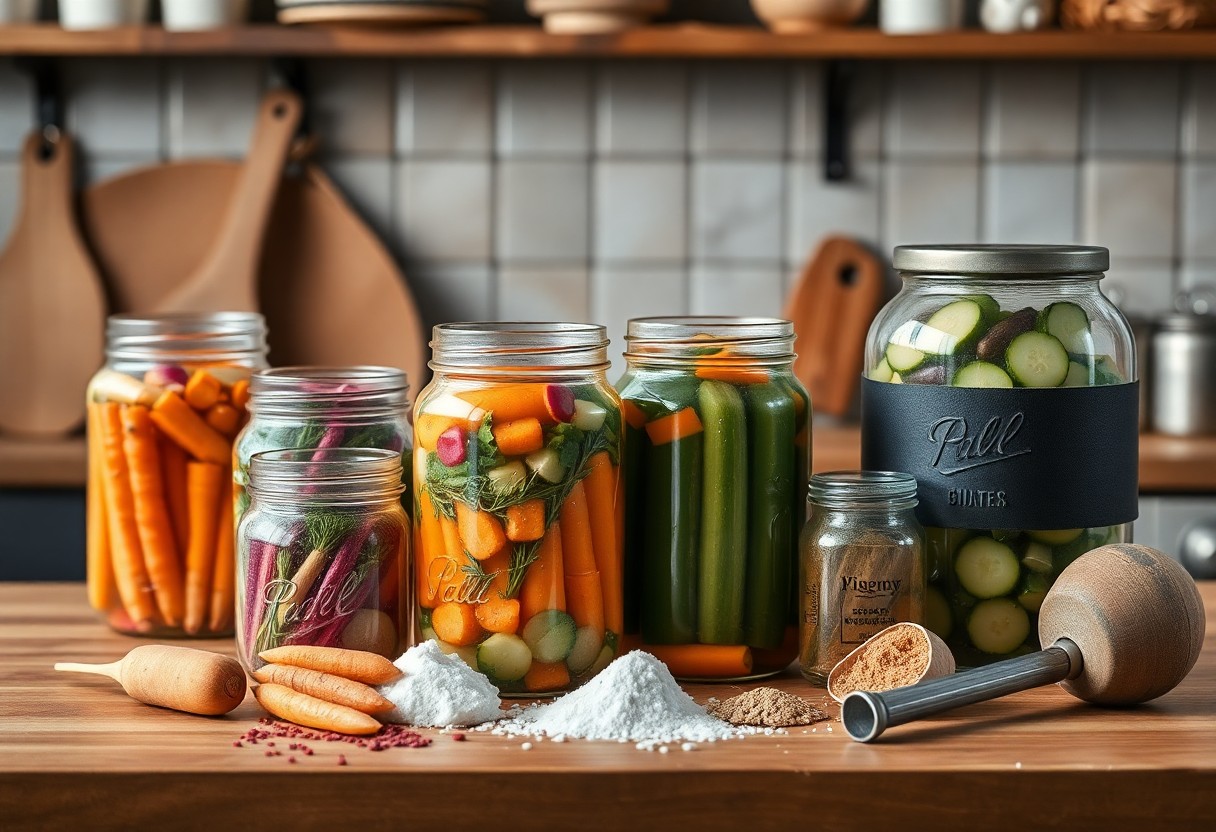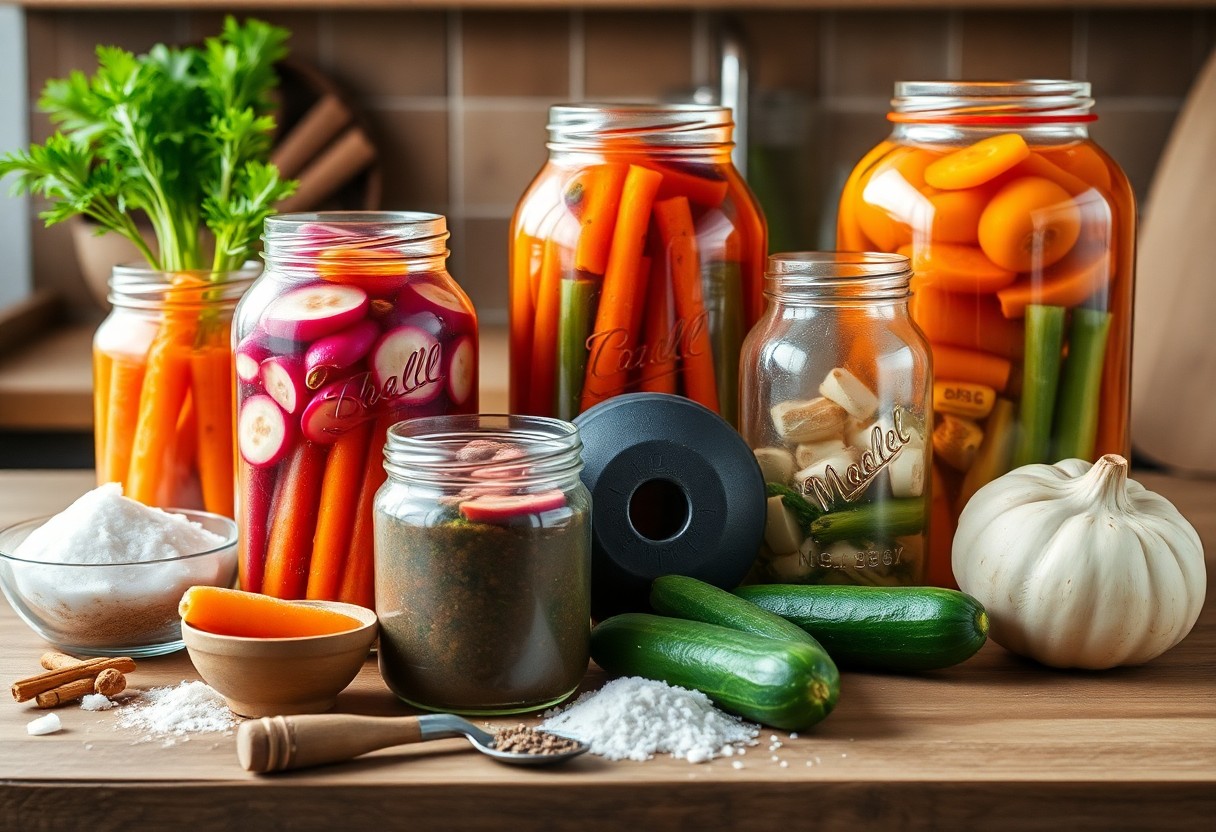What’s the Best Way to Ferment Vegetables?
There’s something magical about transforming ordinary vegetables into probiotic-rich, tangy delights through fermentation. When you master this ancient preservation technique, you’ll unlock a world of flavors while boosting your gut health. Your journey into vegetable fermentation doesn’t need to be complicated, but following the right steps is vital for safe and successful results. Whether you’re new to fermenting or looking to refine your skills, this guide will walk you through the fundamentals of creating delicious, living foods in your own kitchen.
Types of Fermentation
To understand vegetable fermentation better, you should know about the two main processes: lactic acid fermentation and alcoholic fermentation. Each method creates distinct flavors and offers unique health benefits. This guide will help you choose the right technique for your needs.
| Lactic Acid Fermentation | Alcoholic Fermentation |
|---|---|
| Produces tangy flavor | Creates alcohol content |
| Uses beneficial bacteria | Uses yeasts |
| No alcohol produced | Sugar converts to alcohol |
| Common in vegetables | Common in beverages |
| Preserves nutrients | Changes nutrient profile |
Lactic Acid Fermentation
You can create delicious fermented vegetables through lactic acid fermentation, where beneficial bacteria convert sugars into lactic acid. This process naturally preserves your vegetables while creating a tangy, complex flavor and enhancing their nutritional value with probiotics.
Alcoholic Fermentation
Clearly, alcoholic fermentation differs from lactic acid fermentation as it involves yeasts converting sugars into alcohol. This process is less common for vegetables but creates unique flavors in certain fermented foods.
Lactic acid bacteria and yeasts work together in alcoholic fermentation to create complex flavors. During this process, carbon dioxide is released, which can cause pressure buildup in your fermentation vessels. You should always use proper containers and monitor fermentation carefully to prevent excessive pressure.
Step-by-Step Guide to Fermenting Vegetables
While fermenting vegetables might seem complex, following a systematic approach ensures successful and safe results. You’ll need to understand the basic principles and gather the right equipment before starting your fermentation journey.
| Primary Items | Optional Items |
| Clean glass jars Weights Salt Cutting board Sharp knife | Airlock lids pH strips Fermentation crock Cabbage pounder Glass weights |
Preparation
One of your first tasks is to properly clean and sanitize your fermentation vessels. You’ll need to wash your vegetables thoroughly and slice them to your desired size. Maintaining consistent cuts helps ensure even fermentation throughout your batch.
Fermentation Process
Vegetables need a 2-3% salt brine solution to create the right environment for beneficial bacteria. You’ll want to keep your vegetables fully submerged under the brine to prevent mold growth and ensure proper fermentation.
With proper temperature control (65-75°F), your fermented vegetables will develop complex flavors over time. You’ll notice bubbling activity within 24-48 hours, indicating that beneficial bacteria are actively working. Monitor your ferments daily, releasing excess pressure if needed.
Essential Tips for Successful Fermentation
Assuming you’re ready to start your fermentation journey, several key factors will determine your success. Always use clean equipment and fresh ingredients to prevent unwanted bacteria growth. Keep vegetables fully submerged in brine solution to maintain an anaerobic environment. Choose the right salt concentration – typically 2-3% for most vegetables. The presence of small bubbles and a slightly sour smell indicates your fermentation is progressing well.
Temperature Control
| Ideal Range | 65-72°F (18-22°C) |
| Too Cold | Below 60°F (15°C) |
| Too Warm | Above 75°F (24°C) |
Clearly, maintaining proper temperature is vital for fermentation success. You’ll achieve the best results by keeping your ferments in a controlled environment away from direct sunlight and temperature fluctuations.
Timing and Taste
One of the most personal aspects of fermentation is determining when your vegetables are ready. You’ll notice the flavor becoming more complex and tangy over time, with most vegetables reaching their peak between 5-10 days. The fermentation process can be shortened in warmer temperatures or extended in cooler conditions.
This process requires regular taste testing to achieve your desired flavor profile. You should sample your ferments every few days, watching for signs of successful fermentation like bubbling and a pleasantly sour aroma. If you notice any off-putting smells or mold, discard the batch immediately. Your finished ferments will reward you with enhanced nutritional value and unique, complex flavors.
Factors to Consider When Fermenting
Keep in mind that successful fermentation depends on several key elements working together. Temperature, salt concentration, oxygen exposure, and vegetable quality all play vital roles in the process. Your fermentation environment should maintain a consistent temperature between 65-75°F (18-24°C) for optimal results. Knowing these fundamentals will help you achieve predictable, safe, and delicious fermented vegetables every time.
Vegetable Selection
Now that you’re ready to start fermenting, choosing the right vegetables is necessary. Select fresh, unblemished produce at peak ripeness for the best results. Your vegetables should be firm and crisp, free from soft spots or signs of decay. You’ll want to avoid using produce treated with preservatives or waxed vegetables, as these can interfere with the fermentation process.
Salt Concentration
Selection of the right salt type and concentration is fundamental to your fermentation success. Use non-iodized salt, such as sea salt or kosher salt, as iodine can inhibit beneficial bacteria growth. Your brine should typically contain 2-3% salt concentration for most vegetable ferments. Knowing the correct salt-to-water ratio will ensure your ferments are both safe and flavorful.
Consider that salt concentration directly impacts your fermentation’s safety and flavor profile. Too little salt can lead to spoilage and unwanted bacteria growth, while too much salt will slow down fermentation and result in an overly salty product. You’ll need to adjust your salt levels based on the vegetables you’re fermenting and your personal taste preferences. For leafy greens, use a lighter brine, while harder vegetables can handle a stronger salt concentration.
Pros and Cons of Fermenting Vegetables
Now, before you examine fermentation, it’s imperative to understand both the advantages and potential drawbacks of this preservation method. While fermentation offers numerous benefits, from enhanced nutrition to extended shelf life, it also requires patience and attention to detail.
Health Benefits
Clearly, fermented vegetables offer significant health advantages. Your digestive system benefits from the probiotics created during fermentation, while your immune system gets a boost from the increased vitamin content. The process also makes nutrients more bioavailable, meaning your body can absorb them more effectively.
Challenges and Risks
For beginners, fermentation can present several obstacles. You need to maintain proper sanitation to avoid harmful bacteria growth. Temperature fluctuations can affect your results, and there’s always the possibility of mold development if conditions aren’t ideal.
To ensure safety, you must monitor your ferments regularly and learn to distinguish between normal fermentation signs and dangerous contamination. Your equipment needs to be properly sanitized, and vegetables must be completely submerged in brine to prevent spoilage. Understanding these challenges helps you create successful, safe ferments.
Final Words
Ultimately, your success in fermenting vegetables depends on maintaining the right conditions throughout the process. You’ll achieve the best results by keeping your vegetables fully submerged in brine, using the correct salt ratio, and maintaining a consistent temperature between 65-72°F (18-22°C). Your fermentation journey becomes easier when you start with clean equipment and fresh produce. By following these fundamental principles and staying patient through the fermentation period, you’ll create flavorful, probiotic-rich vegetables that can enhance your meals and support your gut health.







